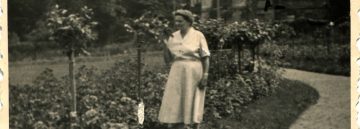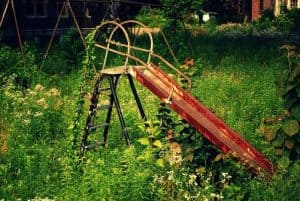
Exploring Documentary Evidence
A variety of sources can be used to help you learn more about the original garden and the history of the property. The aim in carrying out this research is to learn as much as possible about:
- the layout of the grounds, landscape or gardens surrounding the property both now and in the past;
- plans, maps and previous designs for any part of the landscape;
- specific features – trellises, sculpture sundials, steps, and so on;
- how the landscape was used in the past.,/li>
- Sources of information might include:
- house deeds and other ownership documents;
- diaries and letters written by residents or visitors to the property;
- parish records;
- maps;
- old newspaper articles;
- travel accounts;
- previous design plans and notes. If the garden was created by a garden designer his or her original drawings may still be available. The garden may also have been worked on by other designers in the intervening years.
- drawings, sketches and paintings;
- photographs – unfortunately, these did not exist until the second quarter of the 19th Century. All visual records are particularly valuable because they show the garden exactly as it was. It is more difficult when relying on written records as these are open to interpretations and over time meanings can change.
- oral history – stories that people remember. Long-time residents of the area may remember stories relevant to the garden that helps to fill in gaps or point to other sources of information.
If there are few records for the garden in question, you can refer to records for other gardens created in the same period. They will give you a strong indication of how the garden might have looked at the time – including plants, hard landscaping, sculpture and other features – and provide a starting point for your design.
Documentary evidence will hopefully reveal something of the history and evolutions of the garden. Many old gardens will have gone through a series of additions, developments and phases, and it should not simply be assumed that our job is to return the garden to its original form. Every phase of the garden’s history has its own validity and so the decision on how to restore the garden and to which part in its history needs careful consideration and consultation with the client. In many cases, key changes during the garden’s history (which are also part of the history of the property) will be retained and restored.
For other clients, however, an authentic recreation or restoration of the original garden is more important and then the project may involve removing later additions to the garden.
Assessing Existing Plants and Features
In any ornamental garden existing plants and features should be considered both within the wider content of the garden design – for example, what do they contribute to the design? – and also on an individual basis.
Factors to be considered might include:
key plants
- Is the plant in good condition?
- Are there any signs of disease, pests or other health problem? If so can it be treated?
- Is the plant form attractive or is it overgrown, distorted or misshapen? Some plants become unattractive with age. In addition, some variegated plants develop shoots that show reversion (are not variegated). If this has not gone too far pruning may be used to resolve the problem. Do trees have large branches at heights where they might cause a hazard? If so can pruning or other renovation work be used to improve their appearance or remove the hazard?
- How does the plant fit into its current situation? Does it sit comfortably with its neighbours or are they crowding each other? Is it casting a shadow on neighbouring plants?
- If it is next to the house or other building how does it sit in relation to the building? Is it blocking light to a window perhaps? Or reducing access to a gate or door?
- How does the plant fit within the wider design?
key features:
-
- Is the feature in good condition?
- If not can it be renovated?
- If so how does it sit within its context? How does it fit within the content of the wider design?

paving, patios, steps, walls and fences:
- What condition is the hard landscaping in?
- Is it to be retained or replaced?
- If the hard landscaping is in poor repair can this be corrected?
The neglect of a garden may lead to a number of problems – in particular if plants are very overgrown it can make it difficult to see exactly how the original garden was intended to look, for instance, to identify where there were open spaces or where there were differences in height in border planting? In addition, some key plants and features may have been lost (this is why documentary evidence can be so important). Important shrubs and herbaceous plants may be hidden in the undergrowth.
A thorough investigation can identify those plants and features that are to be retained in the renovated garden and those that need to be removed. At this stage the gardener should carefully note the renovation work required for each of these key plants and other features. Before doing so it may be necessary to seek an expert opinion, especially if the plant or feature concerned is rare or potentially sensitive. In some cases it may be important to check the authenticity of a particular feature or plant variety with an appropriate authority.
All plants and features that are to be retained should also be clearly marked on the plan of the garden. Plants should be clearly indicated before any work begins, perhaps using waterproof tags or ties, and if necessary they may be temporarily protected with a small fence or wrapping (e.g. bubble wrap).
In some cases where substantial groundwork is to be undertaken it may be necessary to remove the feature while work goes on, although it is not generally advisable to remove well-established plants.
Examples of plants that may be retained include: less common or fine specimens of mature trees and shrubs; collections of one genus or group – such as old shrub roses, lilac, rhododendron, dwarf conifers, iris x germanica, hemerocallis, primula, geranium, narcissus, ferns, hedges and topiary, fine lawns, and established groups of naturalised or native plants.
Examples of features that might be retained include: statues, ornaments, ironwork, sculpture, wood carvings, fountains, arches, seats, natural stone paving.
Before work begins it will also be important to consider protection of surfaces such as paths, steps, ramps and walls. These may need to be covered in a thick protective cover.
If large machinery needs to be brought on site, such as a tree spade or a small digger, then careful thought should be given to the best means of access. It may also be necessary both to remove bulky material from the garden and to move it around the garden – examples include large trees or features that are to removed or relocated, soil and hard landscaping materials. Careful planning will be required to ensure that this is achieved smoothly without causing damage to existing elements of the garden. Where possible the renovation project should be planned so that all of the heaviest work is carried out before significant replanting occurs, as this reduces the risk of newly finished areas being damaged by work on other parts of the garden. If it is not possible to plan the order of work in this way, then steps should be taken to ensure that the completed areas are well-protected.
